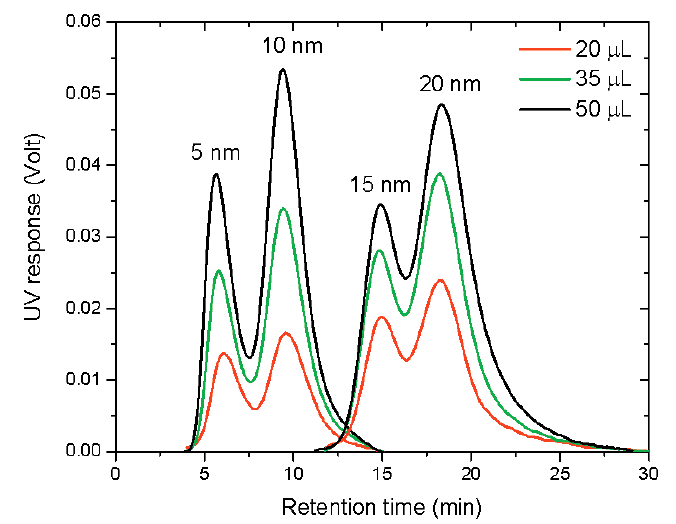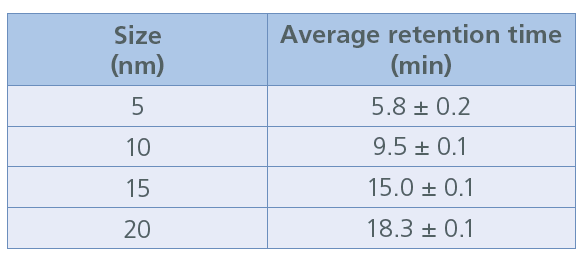Introduction
Gold nanoparticles (AuNPs) are used in biomedical applications due to their stability and versatility in accommodating a variety of surface functionalities. This enables AuNPs to be used for imaging, as well as increasing applications in therapeutics [1]. Accurate characterization of synthesized AuNPs is important to ensure efficacy and patient safety. Commonly used protocols for synthesizing AuNPs generate particles with diameters less than 20 nm. Particles in this size range can be difficult or impossible to accurately measure using single particle inductively coupled plasma mass spectrometry (spICP-MS) [2], and particle suspensions with significant polydispersity will not be characterized accurately by batch dynamic light scattering (DLS) [3, 4].
In this Application Note, we present data on separation of a AuNP mixture containing four particle sizes using Asymmetrical Flow Field-Flow Fractionation (AF4) coupled to a UV/Vis detector. A schematic for the AF4 channel is shown in Figure 1. The combination of cross flow and channel flow cause size separation over the course of the analysis, with smaller particles eluting to connected detectors before larger particles [5].

Experimental Details And Results
Four different sizes of AuNPs (from British BioCell International) were combined to create two polydisperse mixtures: 5 nm and 10 nm; 15 nm and 20 nm. The total gold concentrations of the mixtures were 20 ppm. To separate by size and characterize the AuNPs, an AF4 system (Postnova AF2000) was used with an in-line UV/Vis detector. The experiment was performed with a 10 kDa regenerated cellulose membrane. An AF4 carrier solution of nanopure water was used in the measurements. Three injection volumes were used for each experiment to demonstrate reproducibility when loading mass in the FFF channel varies.
A mixture of all four AuNPs was prepared and analyzed for hydrodynamic diameter by DLS (Malvern Zetasizer) to compare the batch measurement with separation by AF4-UV/Vis.
The UV response for the AuNPs samples is shown in Figure 2. Each NP is well-resolved from the others in the mixtures, with excellent resolution. The peak area scales well as injection volume increases, as the UV/Vis detector is sensitive to particle concentration.
The average retention times for each AuNP size are presented in Table 1, with standard deviations. The retention time reproducibility with varying injection volume is very good, with % relative standard deviations all below 4.5 %.
Batch mode DLS measurements on a mixture of the 4 AuNPs used in this study reported a hydrodynamic diameter of 26.6 ± 1.5 nm (Z-average). This is very useful as a screening tool to approximate the size range of particles in solution, but the AF4-UV/Vis method produced much higher resolution size information for this nanoparticle mixture.
Conclusion
From the data presented here using AuNPs, we see that AF4-UV can separate mixtures of small NPs in the range of 5-20 nm with near-baseline resolution. The polydispersity of these samples challenged DLS’s ability to accurately measure particle size, and spICP-MS (not used in this study) could likely not differentiate the 5 and 10 nm AuNPs from the ionic background signal.
References
[1] Y. Yeh, B. Creran, V. M. Rotello, Nanoscale, 2012, 4(6), 1871–1880.
[2] S. Lee, X. Bi, R. B. Reed, J. F. Ranville, P. Herckes, P. Westerhoff, Environmental Science and Technology, 2014, 48 (17), 10291-10300.
[3] W. Anderson, D. Kozak, V.A. Coleman, Å. K. Jämting, M. Trau,. Journal of Colloid and Interface Science, 2013, 405, 322–330.
[4] Malvern Panalytical, Technical Note, Dynamic Light Scattering: An Introduction in 30 Minutes, 2017.
[5] R. Drexel, V. Sogne, M. Dinkel, F. Meier, T. Klein, Journal of Visualized Experiments, 2020, 163, e61757.



